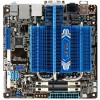Asus AT5IONT-I AT5IONT-I User's manual - Page 18
for AT5IONT-I DELUXE only - hdmi audio
 |
View all Asus AT5IONT-I manuals
Add to My Manuals
Save this manual to your list of manuals |
Page 18 highlights
6. Line In port (light blue). This port connects to the tape, CD, DVD player, or other audio sources. 7. Line Out port (lime). This port connects to a headphone or a speaker. In the 4, 6, and 8-channel configurations, the function of this port becomes Front Speaker Out. 8. Microphone port (pink). This port connects to a microphone. Refer to the audio configuration table below for the function of the audio ports in 2, 4, 6, or 8-channel configuration. Audio 2, 4, 6, or 8-channel configuration Port Light Blue (Rear panel) Lime (Rear panel) Pink (Rear panel) Lime (Front panel) Headset 2-channel Line In Line Out Mic In - 4-channel Rear Speaker Out Front Speaker Out Mic In - 6-channel Rear Speaker Out Front Speaker Out Bass/Center - 8-channel Rear Speaker Out Front Speaker Out Bass/Center Side Speaker Out To configure an 8-channel audio output: Use a chassis with HD audio module in the front panel to support 8-channel audio output. 9. USB 3.0 ports 1 and 2. These two 4-pin Universal Serial Bus (USB) ports are for USB 3.0 devices. 10. eSATA port. This port connects to an external Serial ATA hard disk drive. 11. USB 2.0 ports 3 and 4. These two 4-pin Universal Serial Bus (USB) ports are for USB 2.0 devices. 12. DVI-D port. This port is for any DVI-D compatible device and is HDCP compliant allowing playback of HD DVD, Blu-ray, and other protected content. 13. HDMI port. This port is for a High-Definition Multimedia Interface (HDMI) connector, and is HDCP compliant allowing playback of HD DVD, Blu-Ray, and other protected content. 14. PS/2 Keyboard port (purple). This port is for a PS/2 keyboard. 15. DC power port (for AT5IONT-I DELUXE only). This port connects to an DC power adapter. 1-9 Chapter 1: Product introduction















